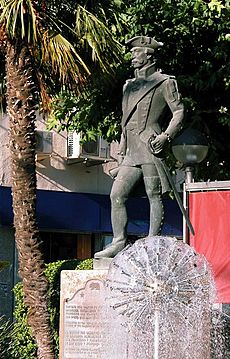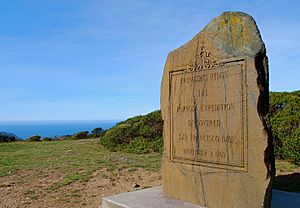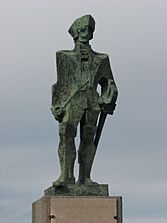Gaspar de Portolá facts for kids
Quick facts for kids
Gaspar de Portolá
|
|
|---|---|
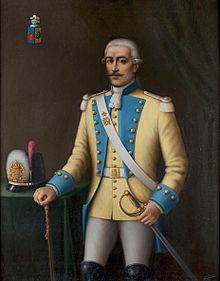 |
|
| Governor of the Californias | |
| In office November 30, 1767 – July 9, 1770 |
|
| Monarch | Charles III |
| Preceded by | Office established |
| Succeeded by | Pedro Fages |
| Personal details | |
| Born |
Gaspar de Portolà i Rovira
January 1, 1716 Os de Balaguer, Catalonia |
| Died | October 10, 1786 (aged 70) Lleida, Catalonia |
| Resting place | Lleida, Catalonia |
| Signature | |
| Military service | |
| Allegiance | |
| Branch/service | |
| Rank | Captain |
Gaspar de Portolá y Rovira (born January 1, 1716 – died October 10, 1786) was a Spanish soldier and explorer. He became the first governor of the region known as The Californias from 1767 to 1770. Portolá is famous for leading an important expedition into what is now the state of California. His journey helped Spain claim new lands and led to the founding of cities like San Diego and Monterey. Many places in California still have names he gave them.
Contents
Early Life and Military Service
Gaspar de Portolá was born in Os de Balaguer, Catalonia, Spain, on January 1, 1716. He came from a noble family. As a young man, Portolá joined the Spanish Army and became an officer. He fought in wars in Italy and Portugal.
Later, he was given a special task. He helped manage the transfer of missions in Baja California. These missions were religious settlements. He made sure they were handed over from one group of missionaries, the Jesuits, to others, the Franciscans and then the Dominicans.
Exploring California
Spain's Reasons for Exploration
Spain wanted to expand its control along the Pacific Coast. They aimed to establish new missions and settlements. One reason was to spread the Catholic faith. Another was to find new sources of wealth. Spain also worried that other countries, like Britain and Russia, might claim these lands first. British explorers were active in the Pacific, and Russian fur hunters were moving east from Siberia.
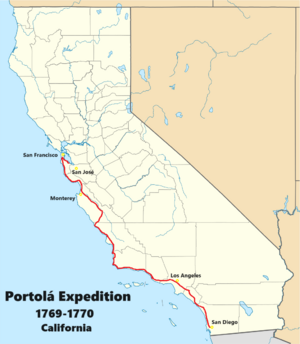
In 1768, King Charles III decided to send a large expedition. The goal was to establish colonies and missions at San Diego Bay and Monterey Bay. Earlier explorers, Juan Cabrillo and Sebastián Vizcaíno, had described these areas. Vizcaíno had mapped the California coast in 1602. However, no Spanish settlements were built then. Monterey Bay, though seen by earlier explorers, was not a safe harbor for Spain's ships traveling between Asia and Mexico.
The First Journey Begins
In May 1768, José de Gálvez, a Spanish official, began organizing the expedition. It would travel by both sea and land. Gaspar de Portolá was chosen to lead the entire journey. He was named "Governor of the Californias." Junípero Serra, a Franciscan missionary, led the religious part of the expedition. The sea and land groups planned to meet at San Diego Bay.
Two ships, the San Carlos and the San Antonio, sailed from Baja California in early 1769. At the same time, the land parties began their march north. The land expedition was split into two groups. Captain Fernando Rivera y Moncada led the first group. Their job was to clear a path and interact with the native people. Father Juan Crespí traveled with Rivera, keeping a diary of their journey.
Portolá led the second land group, which included Junípero Serra. This group had missionaries, settlers, and soldiers. They left on May 15, 1769. During this journey, Junípero Serra founded two important missions: San Diego de Alcalá and Mission San Carlos Borromeo de Carmelo.
Challenges and Discoveries
Rivera's group reached San Diego in May 1769. They set up a camp in what is now Old Town San Diego. The ships had a difficult journey. The San Antonio arrived on April 11, and the San Carlos arrived on April 29. Many sailors on the ships became very sick, mostly from scurvy, and some died. When Portolá's land group arrived on June 29, only about half of the original 219 people were still alive.
Portolá was eager to find Monterey Bay. On July 14, 1769, he led his group north from San Diego. The expedition included Father Juan Crespí, 63 soldiers, and 100 mules carrying supplies. They marched about 5 to 10 miles each day. On July 28, they felt an earthquake near the Santa Ana River. They explored many new areas, naming places as they went. They passed through what are now Fullerton, La Habra, and El Monte. The city of La Puente is named after a bridge they built.
On August 2, they reached the area of modern-day Los Angeles. The next day, they followed an Indian trail that is now Wilshire Boulevard to Santa Monica. They continued north, reaching Santa Barbara on August 19. By September 13, they were near San Simeon. The terrain was very difficult along the coast, so they moved inland.
After marching about 400 miles from San Diego, they reached the mouth of the Salinas River on October 1. They believed they had found Monterey Bay. However, they did not recognize it because it looked different from earlier descriptions. They continued north, reaching a creek near present-day Santa Cruz on October 18.
Finding San Francisco Bay
On November 4, after crossing a low mountain range, Portolá's party made an amazing discovery. They saw the huge San Francisco Bay. This bay had never been seen by the Spanish before. This discovery was very important for California's future. Unlike Monterey Bay, San Francisco Bay was protected by land on almost all sides. This made it a much safer harbor for ships.

Earlier explorers had missed San Francisco Bay. This was often due to the thick fog that covered its entrance. If it had been found sooner, Spain might have settled the area much earlier.
Portolá's group then turned back towards San Diego. They explored and named many places south of what is now the Golden Gate. They often had to eat mule meat to survive their long journey. They finally arrived back in San Diego on January 24, 1770. On their way, they passed Monterey Bay again but still did not recognize it.
The Second Expedition to Monterey
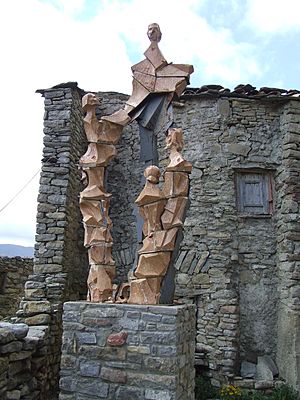
One of Portolá's officers, Captain Vicente Vila, helped him realize they had indeed been at Monterey Bay. After getting more supplies in San Diego, Portolá and Serra decided to try again. They planned a second expedition by land and sea to find the bay and start a colony.
The ship San Antonio sailed on April 16, 1770. Father Serra was on board, along with supplies for the new mission. Portolá led the land expedition, which included Lieutenant Pedro Fages, soldiers, and Father Juan Crespí. They marched north on April 17.
After 36 days, Portolá's land group reached the spot where they had placed a cross before. On May 24, 1770, he finally saw that the bay matched the descriptions from earlier explorers. They had found Monterey Bay! They held a special Mass near an old oak tree. On June 3, 1770, they began building the Mission San Carlos Borromeo de Carmelo and founded the Presidio of Monterey.
Later Years
With Monterey Bay settled, Governor Portolá's main task was complete. He left Captain Pedro Fages in charge of the new settlements. On June 9, Portolá sailed away from California and never returned.
In 1776, Portolá became the governor of Puebla, a region in Mexico. After his time there, he returned to Spain. He served as a commander in a cavalry regiment. On February 7, 1786, he was appointed King's Lieutenant for the castles of Lleida. He passed away in October of that same year.
Remembering Portolá
Many places in California are named after Gaspar de Portolá.
- The city of Portola in Plumas County.
- The town of Portola Valley in San Mateo County.
- The Portola neighborhood of San Francisco.
- Several schools, including Portola Hills Elementary, Portola Elementary, Gaspar de Portola Middle School, Portola Middle School, and Portola High School.
- Portola Parkway in Irvine and Lake Forest.
- Portola Drive in Santa Cruz County.
- Portola Avenue in Palm Desert.
A 9-foot (2.7 m) statue of Portolá was created by Spanish sculptor Josep Maria Subirachs. It was a gift from the Catalan government to California in 1988. This statue was located in Pacifica, California. The statue was removed on January 18, 2024, as communities re-evaluate historical monuments. A large painting of Portolá by Albert Herter hangs in the Los Angeles Central Library.
In World War II, the United States liberty ship SS Gaspar de Portola was named in his honor.
See also
 In Spanish: Gaspar de Portolá para niños
In Spanish: Gaspar de Portolá para niños


